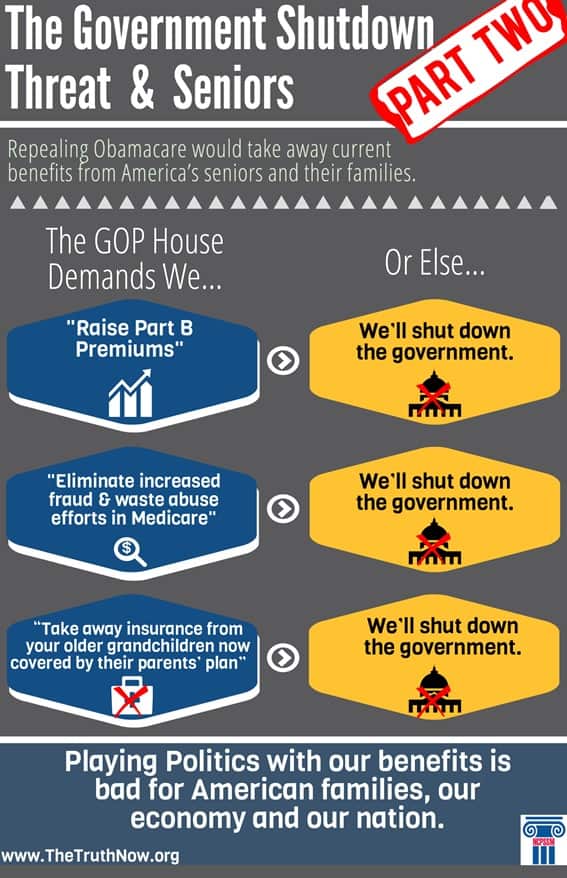Chained CPI Threatens Recovering Economy
New Economic Analysis Shows Billion$ of Dollars and Hundreds of Thousands of Jobs Would Be Lost While Seniors, Veterans & Disabled Put At Risk
The National Committee Foundation has released a startling new report today which details, state by state and Congressional District by District, the true economic impact of adopting a new formula called the “Chained CPI” to measure annual cost of living adjustments (COLA). While some in Washington portray this benefit cut as nothing more than a “technical tweak” the truth is it would be a benefit cut imposed on the oldest and most vulnerable Americans who would be least able to afford it.
economic impact of adopting a new formula called the “Chained CPI” to measure annual cost of living adjustments (COLA). While some in Washington portray this benefit cut as nothing more than a “technical tweak” the truth is it would be a benefit cut imposed on the oldest and most vulnerable Americans who would be least able to afford it.
Our report, “The Chained CPI: Shackling America’s Economic Recovery,” was created in consultation with economist Dean Baker and provides a detailed look at what the adoption of a stingier cost of living adjustment really means for communities and states.
“The negative impact of the Chained CPI should not be ignored or trivialized. This new analysis clearly illustrates just how harmful this COLA cut will be to seniors as well as state economies and local businesses. Washington’s blind determination to cut Social Security benefits in the name of deficit reduction must be stopped and those who continue to peddle the Chained CPI should now explain to American workers, retirees and their families how losing up to $31 billion in economic output and more than 200,000 jobs nationwide is a ‘modest adjustment’ we should accept.” Max Richtman, NCPSSM President/CEO
“Social Security plays an enormously important role in stabilizing the economy during a downturn. It maintains a flow of income to a group of people (the elderly and disabled) who will overwhelmingly spend it. In this way it sustains demand and consumption. The downturn we have seen since 2007 would have undoubtedly been far more severe without Social Security altogether. Any measure that reduces benefits would lessen the stabilizing role that Social Security plays.” Dean Baker, Co-Director Center for Economic and Policy Research
“The Chained CPI: Shackling America’s Economic Recovery,” uses CBO projections to calculate state and Congressional district level impact of the Chained CPI proposal. Many districts with large senior populations would be especially hard-hit by the Chained CPI cuts, top among those:
In Pennsylvania’s 12th congressional district, a largely rural area in the southwest corner of the states, the benefit cuts would be $5.0 million in 2015, $44.9 million in 2020, and $71.3 million in 2023. This would imply a loss of output in the district of $7.2 million in 2015, $65.2 million in 2020, and $103.3 million in 2023. The implied job loss would be 60 in 2015, 440 in 2020, and 630 in 2023.
In Florida’s 16th congressional district, which includes Sarasota and other cities along the Gulf Coast, the benefit cuts would be $6.1 million in 2015, $53.3 million in 2020, and $87.7 million in 2023. This would imply a loss of output in the district of $8.9 million in 2015, $80.2 million in 2020, and $127.2 million in 2023. The implied job loss would be 70 in 2015, 550 in 2020, and 780 in 2023.
Congressman Ted Deutsch is a champion of Social Security, Medicare and Medicaid on Capitol Hill. His legislation extends the solvency of Social Security – without raising the retirement age or slashing benefits – and finally guarantees adequate and accurate cost of living adjustments each year.
“We’ve heard the Chained CPI just slows COLA growth but this cut actually hurts not only seniors but also the communities where they live. No matter how you try, you simply can’t make this proposal sound reasonable to seniors, veterans, the disabled and their families. Losing billions in output, hundreds of thousands of job and taking a step backward in our economy at this moment simply doesn’t make sense. We’ve got to make some changes for Social Security’s long-term solvency and we can do that. But the problem isn’t lavish benefits to seniors.” Rep. Ted Deutsch (D-FL)
While Washington’s well-financed austerity lobby has downplayed the economic impact of losing billions in benefits spent in local communities due to the chained-CPI, step outside the Beltway and state lawmakers and business owners alike understand what this benefit cut would mean:
“Social Security is invaluable not only to our senior citizens, but to our economy. We must stand firm against any change that imperils both our seniors and our economy. Benefit changes that lead to a loss in purchasing power and employment would be detrimental to both national and local economies.” New Jersey Assemblywoman Celeste M. Riley
Abraham Kapusuz owns the Green Olive restaurant in Bridgeton, New Jersey. The vast majority of his patrons depend on Social Security and he knows first hand what a cut in benefits would mean to his customers and his business:
“I’ve talked with many of my customers about the chained CPI proposal and they are 100% opposed. Not only would they feel a big pinch in the wallets, but my employees could be hurt too. If I have fewer customers, I obviously can’t keep a payroll of 50 people so some staff would lose their jobs. The chained CPI sounds like a lose-lose proposition. It will hurt my customers, it will hurt me and it will harm my local economy.” Abraham Kapusuz, small business owner
A full breakdown of the economic and employment impact of the Chained CPI, by state and each Congressional District, can be found on the National Committee Foundation’s website.
Government Shutdown Eve



House Republicans want:
To Return Higher Drug Costs for Seniors
No Free Preventive Visits and Screenings
9 years of solvency taken from the Medicare Trust Fund
Raise Part B Premiums
Eliminate extra waste fraud and abuse efforts in Medicare
These are just some of the added Medicare benefits which have already been enacted and enjoyed by millions of seniors thanks to the passage of Obamacare. However, the House GOP is willing to shut down the government, regardless of the negative economic impacts to follow, rather than allow these benefits to stand.
There are some rumblings that the GOP might come back with yet another set of demands after the Senate acts tonight. The House leadership is already staging the next (they believe more win-able) threat to our government…the debt ceiling fight. Here are just a few of the items on the GOP debt ceiling ransom list :
· One Year Debt Limit Increase
o Not a dollar amount increase, but suspending the debt limit until the end of December 2014.
§ Similar to what we did earlier this year.
o Want the year long delay to align with the year long delay of Obamacare.
· One Year Obamacare delay
· Tax Reform Instructions
o Similar to a bill we passed last fall, laying out broad from Ryan Budget principles for what tax reform should look like.
o Gives fast track authority for tax reform legislation
· Energy and regulatory reforms to promote economic growth
o Includes pretty much every jobs bill we have passed this year and last Congress
o All of these policies have important positive economic effects.
o Energy provisions
§ Keystone Pipeline
§ Coal Ash regulations
§ Offshore drilling
§ Energy production on federal lands
§ EPA Carbon regulations
o Regulatory reform
§ REINS Act
§ Regulatory process reform
§ Consent decree reform
§ Blocking Net Neutrality
· Mandatory Spending Reforms
o Mostly from the sequester replacement bills we passed last year
o Federal Employee retirement reform
o Ending the Dodd Frank bailout fund
o Transitioning CFPB funding to Appropriations
o Child Tax Credit Reform to prevent fraud
o Repealing the Social Services Block grant
· Health Spending Reforms
o Means testing Medicare
o Repealing a Medicaid Provider tax gimmick
o Tort reform
o Altering Disproportion Share Hospitals
o Repealing the Public Health trust Fund
We say enough is enough. That’s why the National Committee joined 41 other groups telling Congress we’ll continue to stand against those who want to hold our economy hostage in order to dictate the terms of debate.
How the “Inform Act” actually MisInforms on Social Security & Medicare



For starters, generational accounting doesn’t make a distinction between spending and investment. An appropriation to send a congressional committee on a junket to the Bahamas carries the same weight as building a schoolhouse or a bridge.
That’s a real flaw. The government’s decision in the 1950s to spend billions to create the interstate highway system shows up in generational accounts as a huge burden on post-1950s taxpayers. That’s you and me. But we’re obviously reaping economic benefits from that decision, as will our children and grandchildren.
The same goes for education, which obviously packs a lot of value for its youthful recipients, who are also the taxpayers of the future.
Kotlikoff’s view of Social Security and Medicare, which is that they’re devices for the old to rip off the young, is especially faulty. Middle- and high-income wage-earners are paying their own way in Social Security, as C. Eugene Steuerle of the Urban Institute has shown. According to his figures, a two-income couple who earned an average wage and retired in 2011 had paid an average $598,000 in Social Security taxes (adjusted for inflation) and will collect an average $556,000 in benefits. Sounds like they’re redistributing their income to the young, not the other way around. Low-earning workers do much better, but that’s a redistribution from rich to poor, not young to old.
“There’s no agenda here,” he says. “It’s not a Tea Party agenda or a left-wing agenda for less spending or more spending. It’s about truth in government operations — it’s a be-honest-with-our-kids act.”
That’s disingenuous. For one thing, among the Inform Act’s champions is an organization called The Can Kicks Back. The group bills itself as a grass-roots anti-deficit lobby for today’s younger generations but actually has links to hedge fund billionaire Peter G. Peterson, whose hostility to Social Security and Medicare is a byword.
Pretty soon, this group will launch their full page ad in the New York Times and their so-called “Inform Act” will no doubt work its way through Congress, even though the deficits they claim are at the heart of their proposals continue to be reduced. Clearly the austerity crowd’s goal is to, “never let a crisis go to waste,” and they’re determined to cut benefits to middle class Americans who depend on Social Security and Medicare…regardless of the fiscal facts. The truth is, our nation still faces a system-wide healthcare crisis. Obamacare is a good start but we need to finish the job of bringing down the high cost of healthcare in America, not just in Medicare but in our private system.
Social Security and Hispanics



Each year, Americans observe National Hispanic Heritage Month from September 15 to October 15, by celebrating the histories, cultures and contributions of American citizens whose ancestors came from Spain, Mexico, the Caribbean and Central and South America.
The observation started in 1968 as Hispanic Heritage Week under President Lyndon Johnson and was expanded by President Ronald Reagan in 1988 to cover a 30-day period starting on September 15 and ending on October 15. It was enacted into law on August 17, 1988, on the approval of Public Law 100-402.
The day of September 15 is significant because it is the anniversary of independence for Latin American countries Costa Rica, El Salvador, Guatemala, Honduras and Nicaragua. In addition, Mexico and Chile celebrate their independence days on September 16 and September18, respectively. Also, Columbus Day or Día de la Raza, which is October 12, falls within this 30 day period.
The National Committee will mark the month in a variety of way and will also highlight the importance of Social Security and Medicare to the Hispanic population. For example, did you know?
Hispanics Rely on Social Security for More of Their Retirement Income
While Social Security is expected to be only one part of a person’s retirement income, many minorities rely on it for a large share. Because Hispanics tend to have lower earnings and less pension coverage than white Americans, Social Security is extremely important for Hispanic retirees.
- More than three-fourths (77%) of Hispanic beneficiaries rely on Social Security for at least half their income compared to almost two-thirds (65%) of all beneficiaries
- Approximately 55% of Hispanic beneficiaries rely on Social Security for 90% or more of their income
- Approximately 45% of Hispanic beneficiaries rely on Social Security for all of their income
Minorities rely more heavily on Social Security due to a lack of other income in retirement. Few elderly minorities receive income from pensions and assets. The greatest disparity is in the receipt of income from assets.
- In 2010, 24% of Hispanics received income from private assets, compared with more than 56% of whites
- In 2010, 13% of Hispanics 65 years old and over reported receiving income from private pensions or annuities, compared to 28% of whites 65 years old and older
Elderly Hispanics are more dependent on Social Security than others, because they are more likely to be in poverty than non- Hispanic elderly. They are also more likely to have been poor prior to old age than non- Hispanics. Social Security reduces poverty for Hispanic elderly.
In 2010, 18% of Hispanics 65 years old and older had income below the poverty line, compared to 8% of white elderly.
If not for Social Security, 49% of older Hispanic Americans would be in poverty.
Chained CPI Threatens Recovering Economy
New Economic Analysis Shows Billion$ of Dollars and Hundreds of Thousands of Jobs Would Be Lost While Seniors, Veterans & Disabled Put At Risk
The National Committee Foundation has released a startling new report today which details, state by state and Congressional District by District, the true


Our report, “The Chained CPI: Shackling America’s Economic Recovery,” was created in consultation with economist Dean Baker and provides a detailed look at what the adoption of a stingier cost of living adjustment really means for communities and states.
“The negative impact of the Chained CPI should not be ignored or trivialized. This new analysis clearly illustrates just how harmful this COLA cut will be to seniors as well as state economies and local businesses. Washington’s blind determination to cut Social Security benefits in the name of deficit reduction must be stopped and those who continue to peddle the Chained CPI should now explain to American workers, retirees and their families how losing up to $31 billion in economic output and more than 200,000 jobs nationwide is a ‘modest adjustment’ we should accept.” Max Richtman, NCPSSM President/CEO
“Social Security plays an enormously important role in stabilizing the economy during a downturn. It maintains a flow of income to a group of people (the elderly and disabled) who will overwhelmingly spend it. In this way it sustains demand and consumption. The downturn we have seen since 2007 would have undoubtedly been far more severe without Social Security altogether. Any measure that reduces benefits would lessen the stabilizing role that Social Security plays.” Dean Baker, Co-Director Center for Economic and Policy Research
“The Chained CPI: Shackling America’s Economic Recovery,” uses CBO projections to calculate state and Congressional district level impact of the Chained CPI proposal. Many districts with large senior populations would be especially hard-hit by the Chained CPI cuts, top among those:
In Pennsylvania’s 12th congressional district, a largely rural area in the southwest corner of the states, the benefit cuts would be $5.0 million in 2015, $44.9 million in 2020, and $71.3 million in 2023. This would imply a loss of output in the district of $7.2 million in 2015, $65.2 million in 2020, and $103.3 million in 2023. The implied job loss would be 60 in 2015, 440 in 2020, and 630 in 2023.
In Florida’s 16th congressional district, which includes Sarasota and other cities along the Gulf Coast, the benefit cuts would be $6.1 million in 2015, $53.3 million in 2020, and $87.7 million in 2023. This would imply a loss of output in the district of $8.9 million in 2015, $80.2 million in 2020, and $127.2 million in 2023. The implied job loss would be 70 in 2015, 550 in 2020, and 780 in 2023.
Congressman Ted Deutsch is a champion of Social Security, Medicare and Medicaid on Capitol Hill. His legislation extends the solvency of Social Security – without raising the retirement age or slashing benefits – and finally guarantees adequate and accurate cost of living adjustments each year.
“We’ve heard the Chained CPI just slows COLA growth but this cut actually hurts not only seniors but also the communities where they live. No matter how you try, you simply can’t make this proposal sound reasonable to seniors, veterans, the disabled and their families. Losing billions in output, hundreds of thousands of job and taking a step backward in our economy at this moment simply doesn’t make sense. We’ve got to make some changes for Social Security’s long-term solvency and we can do that. But the problem isn’t lavish benefits to seniors.” Rep. Ted Deutsch (D-FL)
While Washington’s well-financed austerity lobby has downplayed the economic impact of losing billions in benefits spent in local communities due to the chained-CPI, step outside the Beltway and state lawmakers and business owners alike understand what this benefit cut would mean:
“Social Security is invaluable not only to our senior citizens, but to our economy. We must stand firm against any change that imperils both our seniors and our economy. Benefit changes that lead to a loss in purchasing power and employment would be detrimental to both national and local economies.” New Jersey Assemblywoman Celeste M. Riley
Abraham Kapusuz owns the Green Olive restaurant in Bridgeton, New Jersey. The vast majority of his patrons depend on Social Security and he knows first hand what a cut in benefits would mean to his customers and his business:
“I’ve talked with many of my customers about the chained CPI proposal and they are 100% opposed. Not only would they feel a big pinch in the wallets, but my employees could be hurt too. If I have fewer customers, I obviously can’t keep a payroll of 50 people so some staff would lose their jobs. The chained CPI sounds like a lose-lose proposition. It will hurt my customers, it will hurt me and it will harm my local economy.” Abraham Kapusuz, small business owner
A full breakdown of the economic and employment impact of the Chained CPI, by state and each Congressional District, can be found on the National Committee Foundation’s website.
Government Shutdown Eve



House Republicans want:
To Return Higher Drug Costs for Seniors
No Free Preventive Visits and Screenings
9 years of solvency taken from the Medicare Trust Fund
Raise Part B Premiums
Eliminate extra waste fraud and abuse efforts in Medicare
These are just some of the added Medicare benefits which have already been enacted and enjoyed by millions of seniors thanks to the passage of Obamacare. However, the House GOP is willing to shut down the government, regardless of the negative economic impacts to follow, rather than allow these benefits to stand.
There are some rumblings that the GOP might come back with yet another set of demands after the Senate acts tonight. The House leadership is already staging the next (they believe more win-able) threat to our government…the debt ceiling fight. Here are just a few of the items on the GOP debt ceiling ransom list :
· One Year Debt Limit Increase
o Not a dollar amount increase, but suspending the debt limit until the end of December 2014.
§ Similar to what we did earlier this year.
o Want the year long delay to align with the year long delay of Obamacare.
· One Year Obamacare delay
· Tax Reform Instructions
o Similar to a bill we passed last fall, laying out broad from Ryan Budget principles for what tax reform should look like.
o Gives fast track authority for tax reform legislation
· Energy and regulatory reforms to promote economic growth
o Includes pretty much every jobs bill we have passed this year and last Congress
o All of these policies have important positive economic effects.
o Energy provisions
§ Keystone Pipeline
§ Coal Ash regulations
§ Offshore drilling
§ Energy production on federal lands
§ EPA Carbon regulations
o Regulatory reform
§ REINS Act
§ Regulatory process reform
§ Consent decree reform
§ Blocking Net Neutrality
· Mandatory Spending Reforms
o Mostly from the sequester replacement bills we passed last year
o Federal Employee retirement reform
o Ending the Dodd Frank bailout fund
o Transitioning CFPB funding to Appropriations
o Child Tax Credit Reform to prevent fraud
o Repealing the Social Services Block grant
· Health Spending Reforms
o Means testing Medicare
o Repealing a Medicaid Provider tax gimmick
o Tort reform
o Altering Disproportion Share Hospitals
o Repealing the Public Health trust Fund
We say enough is enough. That’s why the National Committee joined 41 other groups telling Congress we’ll continue to stand against those who want to hold our economy hostage in order to dictate the terms of debate.
How the “Inform Act” actually MisInforms on Social Security & Medicare



For starters, generational accounting doesn’t make a distinction between spending and investment. An appropriation to send a congressional committee on a junket to the Bahamas carries the same weight as building a schoolhouse or a bridge.
That’s a real flaw. The government’s decision in the 1950s to spend billions to create the interstate highway system shows up in generational accounts as a huge burden on post-1950s taxpayers. That’s you and me. But we’re obviously reaping economic benefits from that decision, as will our children and grandchildren.
The same goes for education, which obviously packs a lot of value for its youthful recipients, who are also the taxpayers of the future.
Kotlikoff’s view of Social Security and Medicare, which is that they’re devices for the old to rip off the young, is especially faulty. Middle- and high-income wage-earners are paying their own way in Social Security, as C. Eugene Steuerle of the Urban Institute has shown. According to his figures, a two-income couple who earned an average wage and retired in 2011 had paid an average $598,000 in Social Security taxes (adjusted for inflation) and will collect an average $556,000 in benefits. Sounds like they’re redistributing their income to the young, not the other way around. Low-earning workers do much better, but that’s a redistribution from rich to poor, not young to old.
“There’s no agenda here,” he says. “It’s not a Tea Party agenda or a left-wing agenda for less spending or more spending. It’s about truth in government operations — it’s a be-honest-with-our-kids act.”
That’s disingenuous. For one thing, among the Inform Act’s champions is an organization called The Can Kicks Back. The group bills itself as a grass-roots anti-deficit lobby for today’s younger generations but actually has links to hedge fund billionaire Peter G. Peterson, whose hostility to Social Security and Medicare is a byword.
Pretty soon, this group will launch their full page ad in the New York Times and their so-called “Inform Act” will no doubt work its way through Congress, even though the deficits they claim are at the heart of their proposals continue to be reduced. Clearly the austerity crowd’s goal is to, “never let a crisis go to waste,” and they’re determined to cut benefits to middle class Americans who depend on Social Security and Medicare…regardless of the fiscal facts. The truth is, our nation still faces a system-wide healthcare crisis. Obamacare is a good start but we need to finish the job of bringing down the high cost of healthcare in America, not just in Medicare but in our private system.
Social Security and Hispanics



Each year, Americans observe National Hispanic Heritage Month from September 15 to October 15, by celebrating the histories, cultures and contributions of American citizens whose ancestors came from Spain, Mexico, the Caribbean and Central and South America.
The observation started in 1968 as Hispanic Heritage Week under President Lyndon Johnson and was expanded by President Ronald Reagan in 1988 to cover a 30-day period starting on September 15 and ending on October 15. It was enacted into law on August 17, 1988, on the approval of Public Law 100-402.
The day of September 15 is significant because it is the anniversary of independence for Latin American countries Costa Rica, El Salvador, Guatemala, Honduras and Nicaragua. In addition, Mexico and Chile celebrate their independence days on September 16 and September18, respectively. Also, Columbus Day or Día de la Raza, which is October 12, falls within this 30 day period.
The National Committee will mark the month in a variety of way and will also highlight the importance of Social Security and Medicare to the Hispanic population. For example, did you know?
Hispanics Rely on Social Security for More of Their Retirement Income
While Social Security is expected to be only one part of a person’s retirement income, many minorities rely on it for a large share. Because Hispanics tend to have lower earnings and less pension coverage than white Americans, Social Security is extremely important for Hispanic retirees.
- More than three-fourths (77%) of Hispanic beneficiaries rely on Social Security for at least half their income compared to almost two-thirds (65%) of all beneficiaries
- Approximately 55% of Hispanic beneficiaries rely on Social Security for 90% or more of their income
- Approximately 45% of Hispanic beneficiaries rely on Social Security for all of their income
Minorities rely more heavily on Social Security due to a lack of other income in retirement. Few elderly minorities receive income from pensions and assets. The greatest disparity is in the receipt of income from assets.
- In 2010, 24% of Hispanics received income from private assets, compared with more than 56% of whites
- In 2010, 13% of Hispanics 65 years old and over reported receiving income from private pensions or annuities, compared to 28% of whites 65 years old and older
Elderly Hispanics are more dependent on Social Security than others, because they are more likely to be in poverty than non- Hispanic elderly. They are also more likely to have been poor prior to old age than non- Hispanics. Social Security reduces poverty for Hispanic elderly.
In 2010, 18% of Hispanics 65 years old and older had income below the poverty line, compared to 8% of white elderly.
If not for Social Security, 49% of older Hispanic Americans would be in poverty.




